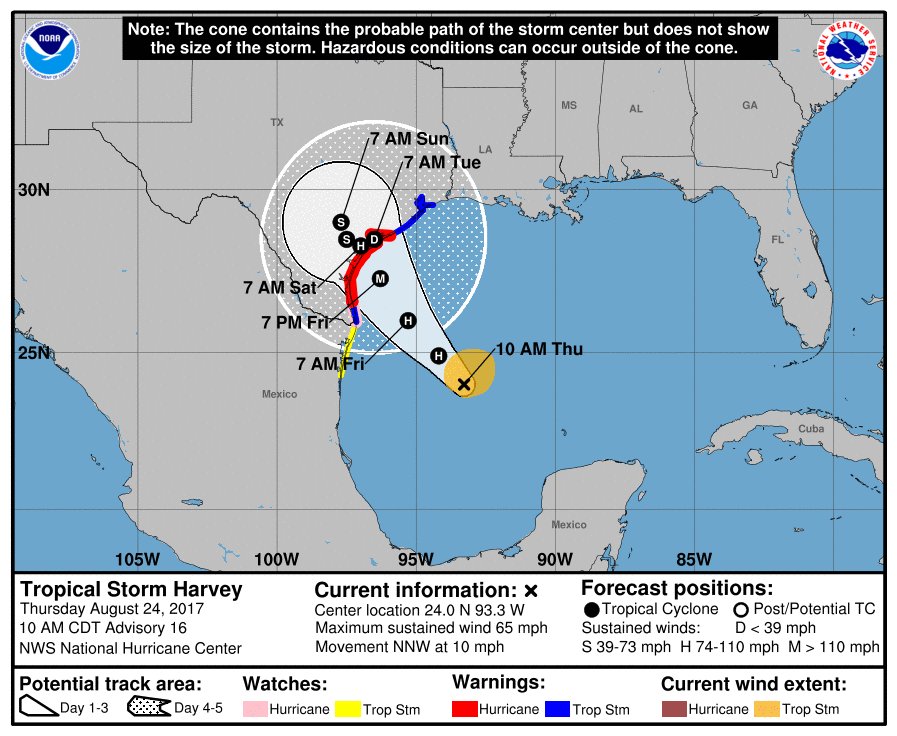Tropical Storm Harvey is rapidly strengthening and is now forecast to become a "major hurricane" when it his the middle Texas coast, the National Hurricane Center said late Thursday morning. "Major hurricane" means Category 3 (winds of at least 111 mph or higher), according to the center. Previously, the storm was projected to reach Category 1 status.
Texans are filling sandbags, stocking up on water and boarding up windows ahead of Tropical Storm Harvey, a system that could develop into a hurricane by Friday.
And while hurricane-force winds are doubtless a concern as Harvey continues rebuilding strength in the Gulf of Mexico, the storm's potential deluge and subsequent flooding may be the biggest danger, according to meteorologists.
The system weakened before reaching tropical storm status early Thursday and is expected to make landfall Friday evening as a Category 1 storm in Corpus Christi, Texas, then stall over the state, the National Hurricane Center said.
"Harvey is likely to bring multiple hazards, including heavy rainfall, storm surge, and possible hurricane conditions to portions of the Texas coast beginning on Friday," the weather service said.
Rainfall amounts increase exponentially when the storm moves at a slower speed, as Harvey's been doing. Earlier this week, the National Hurricane Center warned, "The system is likely to slow down once it reaches the coast, increasing the threat of a prolonged period of heavy rain and flooding across portions of Texas, southwest Louisiana, and northeastern Mexico into early next week."
Compounding potential problems is the tidal cycle. If peak storm surge arrives during high tide, parts of the coast could see 2 to 4 feet of flooding, with the potential of 5 to 7 feet betweenPort Mansfield and San Luis Pass.
While it has been nine years since Texas last saw a hurricane, the state is no stranger to devastating flooding from tropical systems. In 2001, Tropical Storm Allison was a multibillion-dollar disaster for the state, specifically Houston. Allison became nearly stationary for days, dropping more than 30 inches of rain across portions of the city.
A hurricane watch is in effect from north of Port Mansfield to the mouth of the Rio Grande, with a storm surge watch stretching north to High Island, on Galveston Bay.
Harvey could be the first hurricane to hit Texas since 2008 when Hurricane Ike smashed the coast near Galveston. The storm killed 21 people in Texas, Louisiana and Arkansas, and caused widespread destruction.
Texans are filling sandbags, stocking up on water and boarding up windows ahead of Tropical Storm Harvey, a system that could develop into a hurricane by Friday.
And while hurricane-force winds are doubtless a concern as Harvey continues rebuilding strength in the Gulf of Mexico, the storm's potential deluge and subsequent flooding may be the biggest danger, according to meteorologists.
The system weakened before reaching tropical storm status early Thursday and is expected to make landfall Friday evening as a Category 1 storm in Corpus Christi, Texas, then stall over the state, the National Hurricane Center said.
"Harvey is likely to bring multiple hazards, including heavy rainfall, storm surge, and possible hurricane conditions to portions of the Texas coast beginning on Friday," the weather service said.
Rainfall amounts increase exponentially when the storm moves at a slower speed, as Harvey's been doing. Earlier this week, the National Hurricane Center warned, "The system is likely to slow down once it reaches the coast, increasing the threat of a prolonged period of heavy rain and flooding across portions of Texas, southwest Louisiana, and northeastern Mexico into early next week."
Compounding potential problems is the tidal cycle. If peak storm surge arrives during high tide, parts of the coast could see 2 to 4 feet of flooding, with the potential of 5 to 7 feet betweenPort Mansfield and San Luis Pass.
While it has been nine years since Texas last saw a hurricane, the state is no stranger to devastating flooding from tropical systems. In 2001, Tropical Storm Allison was a multibillion-dollar disaster for the state, specifically Houston. Allison became nearly stationary for days, dropping more than 30 inches of rain across portions of the city.
A hurricane watch is in effect from north of Port Mansfield to the mouth of the Rio Grande, with a storm surge watch stretching north to High Island, on Galveston Bay.
Harvey could be the first hurricane to hit Texas since 2008 when Hurricane Ike smashed the coast near Galveston. The storm killed 21 people in Texas, Louisiana and Arkansas, and caused widespread destruction.














